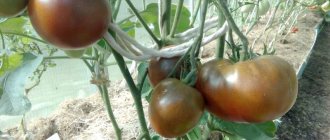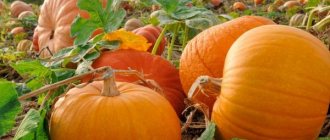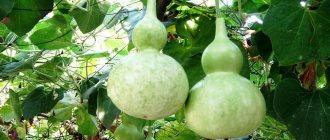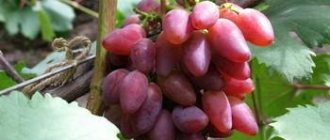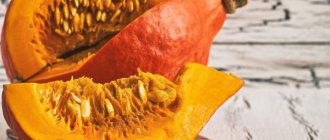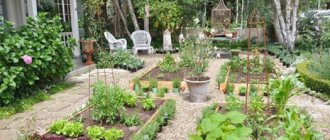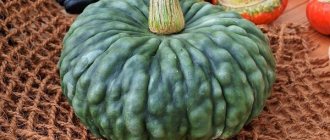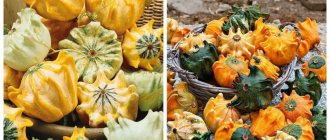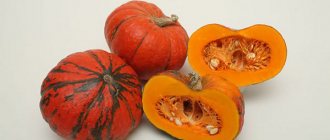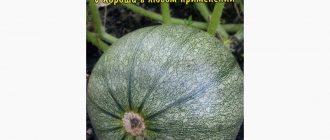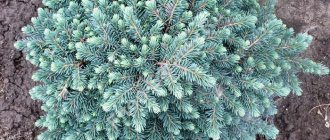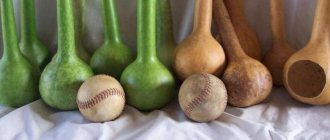Pumpkin is part of traditional dishes around the world. It contains many useful substances that have a positive effect on vision, stomach, intestines, immunity and metabolic processes. Therefore, it is actively grown by gardeners around the world, including in our country.
Breeders annually release new varieties and hybrids that are easy to care for and have an unusual taste. The achievements of agronomists also include the Hazelnut pumpkin. This hybrid is resistant to many diseases and has a nutty aftertaste. Read on to learn how to grow it on your own property.
Characteristics of the variety
The variety belongs to the hybrid class (f1), therefore it is sold exclusively in specialized stores. The ripening period is 90-95 days.
Pumpkin can be sown directly into the ground, bypassing the frost period, or planted as seedlings.
The fruits are not very large, weighing 1-1.5 kg. The pulp is bright orange, tasty, sweet, with pleasant nutty notes.
The following qualities of the variety can be distinguished:
- early ripening;
- prefers sunny places;
- requires the introduction of fertilizing and regular watering;
- The fruits are stored for a long time in cool conditions.
External description
The root system is well developed, the ground vines are long, reaching 4 m. This feature allows the crop to adapt well in dry times and obtain moisture.
The plant is characterized by large leaves and beautiful orange-red inflorescences.
Pollination
The process is carried out by bees. But it is important to control the number of male and female inflorescences.
If changes occur, it is necessary to make adjustments to feeding or carry out pollination using the artificial method.
Characteristics and description of the Russian pumpkin
“Rossiyanka” is a large-fruited, self-pollinating variety of early ripening.
Good agrotechnical characteristics have made this pumpkin one of the most popular in Russia. Brief description of the Russian pumpkin:
- Plant. Climbing, compact. The main stem grows up to 3 m in length. 3 to 4 side branches branch from it. The length of the lashes is 7-8 m. The stem is rounded, covered with hard hairs.
- Leaves. Large, light green.
- Roots. Powerful, go into the ground to a depth of 2.5 m. The roots grow to the sides by 4 m.
- Flowers. Large, yellow-orange in color.
- Fruit. Large, turban-shaped. The bark is fragile, smooth, glossy. The pulp is loose, low-juicy, orange in color, without fibers. The skin and pulp are the same color. The seeds are whitish in color, smooth. The taste of the pulp is sweetish, the aroma is melon.
Growing regions
The “Rossiyanka” variety was bred by Russian breeders specifically for cultivation in unfavorable climatic conditions. The variety was included in the State Register in 1999.
Pumpkin "Rossiyanka" is recommended for the following regions:
- Volgo-Vyatsky.
- East Siberian.
- Central.
- Far Eastern.
The variety is grown almost throughout the entire territory of the Russian Federation - in the North-West, Siberia, and the Urals. Thanks to its early ripening, this variety can be grown in regions with short summers.
Ripening time
Pumpkin “Rossiyanka” is a mid-season variety. The ripening period - from emergence to full ripening - is 90-100 days. Ripening times depend on the time of planting - they are individual for each region.
Productivity
The variety "Rossiyanka" is characterized by high yield. If you properly care for the plantings, you can collect 20-25 kg of fruit from one bush. During large-scale cultivation, up to 30-35 tons of pumpkins are collected from 1 hectare.
The average weight of one fruit is 3.5-4 kg. There are also record-breaking pumpkins - some gardeners managed to grow fruits weighing 30 kg or more.
Resistance to diseases and pests
The “Rossiyanka” variety is characterized by average resistance to diseases and pests. This pumpkin is especially often affected by aphids and fungal diseases, which are combated with chemicals and folk remedies.
Purpose of the variety
The fruits are versatile and tasty; they are used to prepare a wide variety of dishes - cereals, juices, salads, soups, and baked goods. The pulp is tender and smells like melon.
The pulp is rich in fats, proteins, carbohydrates, vitamins B, PP, C, and carotenoids. It contains a lot of salts of calcium, iron, magnesium, and contains trace elements - copper, zinc, cobalt. Suitable for dietary purposes.
Seedling planting method
Planting through seedlings is more popular among gardeners.
This method allows you to reduce the risk of low seed germination, prevent the effect of cold on crops and obtain a stronger crop.
Seeds are sown in cups, trays or boxes in early April. After 25-30 days, strong seedlings are formed, which are transplanted into open ground.
Technology
Seeds are sown in special soil or well-loosened and pre-fertilized soil. It can be a mix of peat, earth and sand.
Coarse sand is evenly laid out at the bottom of the container. Next, the surface is filled with soil and the seeds are sown.
Planting pattern – 100x70 cm.
Make another layer of soil on top. You can use large peat pots - they are buried in the ground along with the seedlings (this allows the plant to better adapt to new conditions).
Sowing seeds in open ground
The main thing is not to freeze the seedlings
According to the description, Hazelnut pumpkin should be planted and planted directly in open ground. Of course, this method is fraught with the possibility of empty seedlings; delicate seeds can be damaged by pests, and not every crop can sprout.
To achieve a good harvest, it is important to skip the frost period and prepare the soil well.
Dates: it is worth targeting the 3rd week of May. The air temperature must be at least 16°.
Technology
Most gardeners prefer to pre-treat the seeds.
You can soak them for several days for soaking and better germination, or use a more modern option - a special growth activator.
The seeds must remain in the liquid for at least a day, and the use of an activator requires treatment for the entire hour.
Once the seeds are ready, they are dried a little and sown in the ground. It is also important to prepare the soil in advance: it is loosened and organic fertilizers are applied. Seeds are planted to a depth of 5 to 10 cm.
General description of butternut squash
This vegetable crop received its name for the specific nutmeg smell that appears when cutting the fruit. The shape and color of the ripened fruits can vary greatly depending on the variety of butternut squash, as can be seen in the photo below, however, some common features can be identified:
- The average weight of nutmeg pumpkin varies from 1 to 10 kg, sometimes among large-fruited varieties there are specimens weighing 25-30 kg.
- The peduncle of the species has 5 sides.
- The pulp of the vegetable is quite dense; there are practically no hollow places in its structure. Its consistency is juicy and fibrous.
- Pumpkin seeds are located in one place, making the fruit easy to cut.
- What distinguishes nutmeg pumpkin from other types is the sweet taste of its pulp.
- The skin of the fruit of most varieties is quite thin, it can be cut off with a knife without much difficulty.
Pumpkin care
The culture itself is considered the easiest to care for. But to achieve better yields, regular watering and fertilizing are required.
The Hazelnut variety does not like overly waterlogged soil, as the leaves and vines may begin to rot. Watering is carried out once a day during the dry period. It is important to loosen the soil well after this.
Pour water carefully so as not to wash off the pollen from the inflorescences. Excessive soil moisture is also harmful to fruits. Therefore, they, together with the lashes, are often raised on supports or covered with sheets of plywood.
Harvest and storage
The crop will feel good before the first frost, but it is important to remove it in a timely manner. This period begins at the end of August and can last almost the whole of September.
Also, the pumpkin itself may indicate that it is time to harvest: the fruits have swelled and turned a deep orange color, become hard, and the leaves of the vines have begun to turn yellow and dry out.
It is best to store the crop in a cool, slightly humid room. Experienced gardeners rearrange the fruits with straw or sawdust. In this form, the vegetable can last almost the entire winter.
Features of cultivation
There are several key features to consider when growing pumpkins.
Seed preparation
Before disembarking, preparations are required:
- Sorting. Sort through the seeds, select only the largest. Remove damaged and empty ones.
- Heating. Spread the selected material in a layer of no more than 10 cm. Heat for about 5 hours at a temperature of 40 degrees.
- Soak. Mix 1 liter of water with 2 tbsp. l. ash. Throw the seeds there and wait 10 hours.
Gardeners recommend putting the seeds in a cool place for an additional few hours.
You can avoid the described procedures if you take seeds that have been stored for 2-3 years after harvest.
To prepare them for planting you need:
- immerse in water at a temperature of 40 degrees for 3-4 hours;
- wrap in a damp cloth and leave for 2-3 days, constantly monitoring the level of moisture.
All of these manipulations are necessary for 2 reasons:
- Growth stimulation. Sprouted seeds sprout faster.
- Protection. They become more resistant to pests.
Choosing a landing site
When choosing a place in the garden, you need to consider the following features:
- Location. It is better to grow pumpkin in an area open to sunlight and protected from the wind. A great place is the south side of the house.
- Availability of support. Most varieties tend to weave. Therefore, you should take care of support in the form of a wall or fence.
- The right soil.
The soil should be nutritious and loose, since pumpkin does not grow well in acidic soil. Starting in the fall, the soil needs to be dug up and fertilizer added. You will need compost and superphosphate. For 1 sq. m, 4 kg of compost and 30 g of superphosphate are added. Lime will help reduce soil acidity. - Predecessor cultures.
It is better to plant after tomatoes, legumes or carrots. It is not recommended to plant in a bed where cucumbers previously grew. - Neighborhood. Pumpkin grows well next to beans and corn.
Diseases and pests
- Bacteriosis manifests itself as brown ulcers on leaves and fruits. Control methods: treatment with Bordeaux liquid. Prevention: treatment with 0.4% copper oxychloride or 1% Bordeaux mixture.
- White rot – covering of fruits and leaves with a white coating and further rotting. Control methods: watering plants only with warm water, treating with 0.5% copper sulfate solution. Prevention: use of foliar fertilizers.
- Root rot is the formation of a constriction, which leads to rotting of the root system and complete loss of the plant. Control methods: watering with previcur solution. Prevention: use of foliar fertilizers, adding an additional layer of soil to the roots.
- Powdery mildew is a white coating on leaves, stems, petioles. Control methods: spraying with colloidal sulfur, isophene, sodium phosphate. Prevention: destruction of weeds and compliance with crop rotation rules.
- Spider mite - damage to leaves by cobwebs. Control methods: spraying with keltan, isophene, ground sulfur. Prevention: spraying the plant with an infusion of onion or garlic peels.
- Aphids - manifested by curling and falling leaves. Control methods: spraying with karbofos. Prevention: timely removal of weeds.
Pumpkin HAZELNUT
Delicious porridge 'Friendship' made from super-pumpkin 'Hazelnut'
Hazelnut Pumpkin (Pumpkin). Brief overview, description of characteristics, where to buy cucurbita pepo seeds
Reviews from gardeners
The pumpkin variety Hazelnut (f1) has earned positive reviews. The vegetable is tasty and healthy. It is very easy to grow it in your garden, and you can use different options for sowing seeds.
This variety remains resistant to most pests, however, it is important to remove weeds in a timely manner, properly water the plants, apply fertilizers and use preventive measures.
As a result, the crop produces a good harvest of small and sweet fruits that can withstand transportation and storage.
Hazelnut pumpkin F1, 2 g Yummy!
You can choose and buy seeds and other products for the garden and home from more than 15,000 items, take care of protection and fertilizers for your plants, purchase useful things for the garden and home and other useful products from our catalogs.
We present to you the whole variety of plant seeds available in Russia.
We are a completely independent company that does not depend on any supplier and does not promote any of them. Therefore, we give you complete freedom of choice. This way we guarantee the widest range of different sources.
https://www.youtube.com/watch?v=sHloyvL3bpw
We provide the most modern way to buy seeds and plants online. We will deliver everything you want to purchase for your garden and home by mail, cash on delivery or courier in Moscow and St. Petersburg and another 300 cities in Russia, as well as at 1000 pick-up points in more than 380 cities!
We believe that it is better to choose seeds and plants in a calm environment, and not in the bustle of store shelves. On the Semenapost.ru website you have as much time to make a decision as you need!
More details
